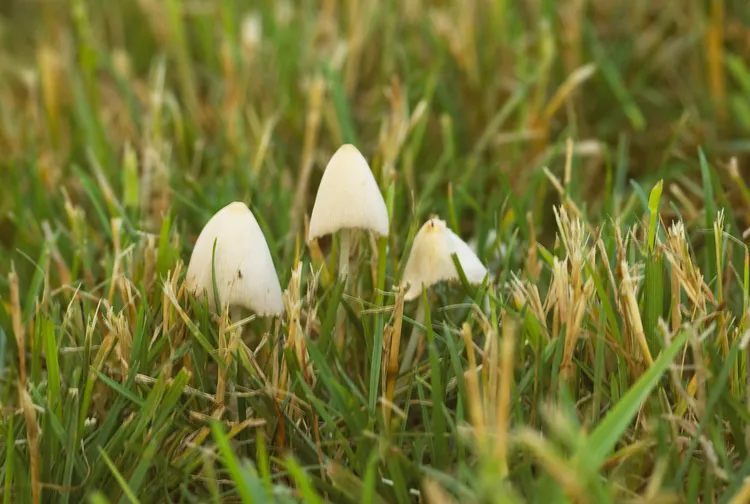While mushrooms are a natural part of the ecosystem and a sign of healthy soil, they may not be healthy for children or pets. To figure out how to get rid of mushrooms in your yard, first you'll need to understand why these fungal fruiting bodies are popping up. Then you'll be able to strategically use the best natural methods explained in this guide to deal with your shroom situation.
Wondering if it's safe to eat the mushrooms you find in your yard? Considering that some types are toxic, and a few can be deadly if ingested, it's best to never eat mushrooms growing in your yard.
Why Are Mushrooms Growing in Your Yard?
Despite how they seem to magically pop up overnight, mushrooms don’t just appear. The mushroom is only the above-ground fruiting body of an entire fungal organism, and usually only last a few days. That fungus will continue to live long after you've seen any mushrooms, thriving on wet, warm organic matter in or on the soil that it's helping to decompose. Many types of fungi that produce mushrooms feed on thatch, grass clippings, dead tree stumps, animal waste, dead roots, and fallen leaves.
Mushrooms tend to be more prevalent during wet years with high rainfall or in an overwatered yard. And shady areas that stay damp are prime locations to find mushrooms popping up through the grass. To get rid of mushrooms in the yard, change the amount of food, moisture, and shade the fungus has; it will struggle, and your mushroom problems will diminish.
Natural Ways to Get Rid of Mushrooms in the Yard
Removing the above-ground mushrooms doesn’t eliminate the underground mycelium, the main body of the fungus that forms the mushrooms. They’ll reappear whenever the conditions are right. To reduce how hospitable your yard is to fungi, work on reducing their food and drying out the yard.
1. Soil Management
Many fungi live in the soil, where they industriously decompose dead plant material, but they slow down or become dormant during dry weather. Aerating your lawn can improve drainage, which reduces how long the soil stays wet. Removing thatch buildup makes things tough for the fungi by removing a good food source. Both steps help your grass be healthy and vigorous, which lowers the likelihood of a mushroom outbreak on your lawn.
2. Dry Things Out
Reducing excess lawn watering is critical to controlling the mushrooms. If your lawn is consistently damp, you’ll probably have mushrooms at some point. In large, flat lawn areas with no gradient, water doesn’t run off quickly after rain or irrigation, and the area can stay wet for days. Reduce the frequency of lawn watering and assist natural drainage by cleaning gutters and redirecting them toward areas with better drainage.
3. Let the Sun Shine
Sunshine dries things out, but heavy shade, like that found under shrubs, conifers, or at the edge of the lawn, can cause damp conditions to persist. Prune low-hanging branches and clean up old debris to let the sun reach the soil. The top inch will dry more quickly, and you’ll have fewer fungi issues.
4. Physically Remove the Mushrooms
Many mushrooms are only a concern because they may be poisonous to people or pets. Removing a mushroom and disposing of it is a quick and temporary solution to the problem. They are usually fragile and can be picked up with gloves, dug under with a shovel, or knocked over with a rake and bagged.
Try to get them when they first pop up before they release spores. However, don’t expect the problem to be gone for good. The fungi live beneath the surface and only reproduce (make a mushroom) when conditions are right. They can survive for years underground. While removing the fruiting bodies before they disseminate spores is helpful, the spores are windborne and can easily blow in from a neighbor’s yard.
Of course, more mushrooms are destroyed by a simple pass of the lawnmower than probably any other method. If you aren’t worried about a pet or child picking them up, mowing them is about as easy as it gets.
Other Remedies
DIY remedies of dish soap and water, baking soda, or vinegar are only mildly effective. Often, the application appears to be effective because the mushrooms go away. However, the fruiting bodies only last a few days anyway. Did the remedy work, or did the mushrooms fade out on their own until next time?
Most fungicides available without a pesticide applicator license are only marginally effective against fungi in the yard. Addressing the conditions needed by the mushrooms is the best long-term solution.




















